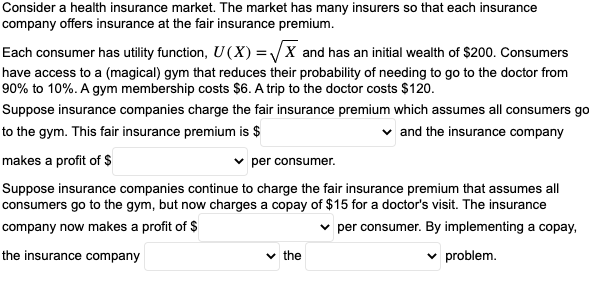Consider a health insurance market. The market has many insurers so that each insurance company offers insurance at the fair insurance premium. Each consumer has utility function, U(X)=√√X and has an initial wealth of $200. Consumers have access to a (magical) gym that reduces their probability of needing to go to the doctor from 90% to 10%. A gym membership costs $6. A trip to the doctor costs $120. Suppose insurance companies charge the fair insurance premium which assumes all consumers go to the gym. This fair insurance premium is $ ✓ and the insurance company makes a profit of $ per consumer. Suppose insurance companies continue to charge the fair insurance premium that assumes all consumers go to the gym, but now charges a copay of $15 for a doctor's visit. The insurance company now makes a profit of $ per consumer. By implementing a copay,
-
Consider a health insurance market. The market has many insurers so that each insurance company offers insurance at the fair insurance premium.
Each consumer has utility function, and has an initial wealth of $200. Consumers have access to a (magical) gym that reduces their probability of needing to go to the doctor from 90% to 10%. A gym membership costs $6. A trip to the doctor costs $120.
Suppose insurance companies charge the fair insurance premium which assumes all consumers go to the gym. This fair insurance premium is $? and the insurance company makes a profit of $? per consumer.
Suppose insurance companies continue to charge the fair insurance premium that assumes all consumers go to the gym, but now charges a copay of $15 for a doctor's visit. The insurance company now makes a profit of $ per consumer. By implementing a copay, the insurance company the problem.

Trending now
This is a popular solution!
Step by step
Solved in 4 steps


